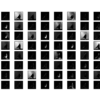The Planet dataset has become a standard computer vision benchmark that involves multi-label classification or tagging the contents satellite photos of Amazon tropical rainforest. The dataset was the basis of a data science competition on the Kaggle website and was effectively solved. Nevertheless, it can be used as the basis for learning and practicing how […]










